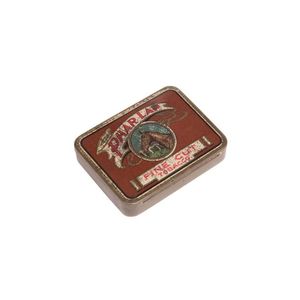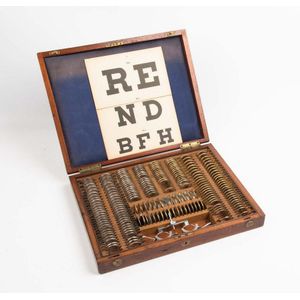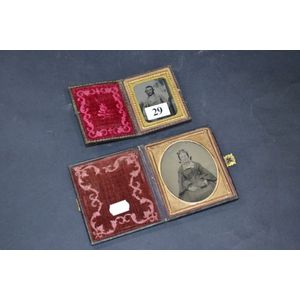Victorian Etruscan Revival Micro Mosaic Swans Brooch
A Victorian etruscan revival micro mosaic brooch, the pierced lozenge shaped panel having a central oval section depicting two white swans on a lake amongst bulrushes with a red skyline, offset by four diamond shaped panels set with white flowers on a blue background, stamped verso with crossed keys, all mounted in 18ct gold, circa 1860. Condition: This piece presents in excellent condition. One small white tile missing from a swans wing, one blue tile missing from a diamond panel. Fitted with a safety chain. Small amount of lead solder to the pin fitting. Indistinguishable hallmark to the pin. Cannot be attributed to any one maker but can be consider a master craftsman from Rome with stamp of crossed keys of the Vatican.
You must be a subscriber, and be logged in to view price and dealer details.
Subscribe Now to view actual auction price for this item
When you subscribe, you have the option of setting the currency in which to display prices to $Au, $US, $NZ or Stg.
This item has been sold, and the description, image and price are for reference purposes only.
- Attributed - A cataloguing term where the item in the opinion of the cataloguers, is a of the period of the artist, craftsman or designer, and which probably in whole or part is the work of that person.
- Victorian Period - The Victorian period of furniture and decorative arts design covers the reign of Queen Victoria from 1837 to 1901. There was not one dominant style of furniture in the Victorian period. Designers used and modified many historical styles such as Gothic, Tudor, Elizabethan, English Rococo, Neoclassical and others, although use of some styles, such as English Rococo and Gothic tended to dominate the furniture manufacture of the period.
The Victorian period was preceded by the Regency and William IV periods, and followed by the Edwardian period, named for Edward VII (1841 ? 1910) who was King of the United Kingdom and the British Dominions and Emperor of India for the brief period from 1901 until his death in 1910. - Verso - Verso is the "back" side of a sheet of paper, art work, coin or medal. The front side is "recto".
- Circa - A Latin term meaning 'about', often used in the antique trade to give an approximate date for the piece, usually considered to be five years on either side of the circa year. Thus, circa 1900 means the piece was made about 1900, probably between 1895 and 1905. The expression is sometimes abbreviated to c.1900.
- Etruscan - The Etruscans were pre-Roman people who mainly inhabited central and part of north Italy, in the area corresponding to Tuscany. The civilisation was active from around 700BC until their assimilation into the Roman Empire in around the 4th century BC.
With the increasing importance of Rome they were virtually wiped out, for Rome would not tolerate a competitive civilization. Many Etruscan rituals and aspects of their culture were taken over by Rome: Etruscan funeral games became the Roman gladiatorial combats and the science of divination came from the Etruscans.
They were also incredible craftsmen in precious metals. It was said that the famous Etruscan Sibylline books of received wisdom were burnt by Rome and that the emperor Claudius was the last person who could read Etruscan, a language that is still largely undeciphered.
Black and red figure vases attributed to the Etruscans provided the basis for the Etruscan style of furniture, decorative arts and decoration first seen in Louis XVI furniture in the 1760s, and then adapted by Robert Adam in England.
The style was characterised by the use of the red and black colourways of the vases, together with motifs such as lions, birds, sphinxes and griffins.
Josiah Wedgwood was inspired by the civilisation, and in 1769 he opened his new ceramic factory at Stoke-on-Trent, naming it "Etruria Works". Using the modeller John Flaxman, he produced wares based on what was thought at the time, to be Etruscan themes.
At the end of the 18th and in the early 19th century, Etruscan themes were seen in glass, jewellery and furniture, and in the 1820s Coalport China produced a range of wares based on the Etruscan themes.
Around that time it was discovered that the archaeological treasures attributed to the Etruscans were of Greek origin, but the description of them as "Etruscan" continued.
This item has been included into following indexes:
Visually similar items

Melbourne: Member's Badge from 1964 (Premiership Year), made by Bertram Bros. Scarce
Sold by
in
for
You can display prices in $Au, $US, $NZ or Stg.

Phar Lap, nice tin 'Phar Lap, Fine Cut Tobacco', manufactured by Myona Cigar Co. Melbourne
Sold by
in
for
You can display prices in $Au, $US, $NZ or Stg.

A travelling opticians case, late 19th early 20th century, 8 cm high, 44 cm wide, 35 cm deep
Sold by
in
for
You can display prices in $Au, $US, $NZ or Stg.

Two daguerreotypes in embossed leather cases, Man and Woman c.1850's
Sold by
in
for
You can display prices in $Au, $US, $NZ or Stg.
